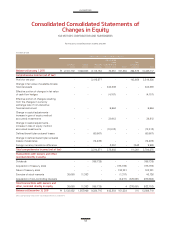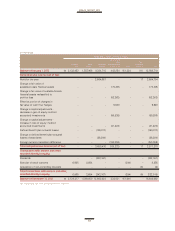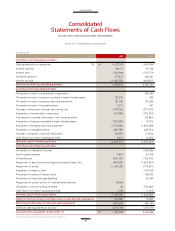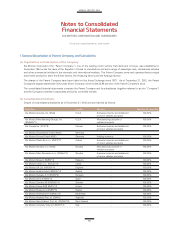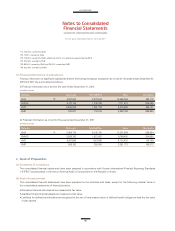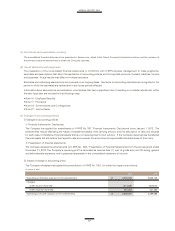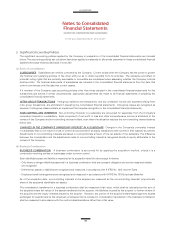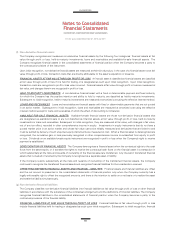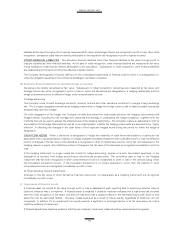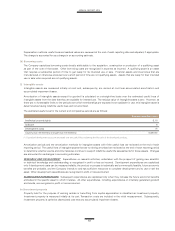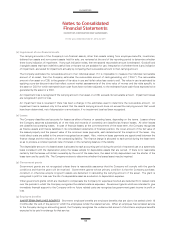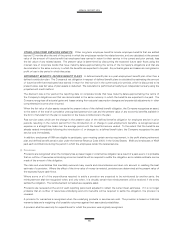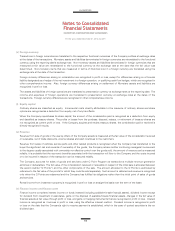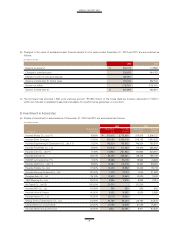Kia 2012 Annual Report Download - page 62
Download and view the complete annual report
Please find page 62 of the 2012 Kia annual report below. You can navigate through the pages in the report by either clicking on the pages listed below, or by using the keyword search tool below to find specific information within the annual report.
FINANCIAL ASSETS MEASURED AT AMORTIZED COST An impairment loss in respect of a financial asset measured at
amortized cost is calculated as the difference between its carrying amount and the present value of its estimated future cash flows
discounted at the asset’s original effective interest rate. If it is not practicable to obtain the instrument’s estimated future cash
flows, impairment losses would be measured by using prices from any observable current market transactions. The Company can
recognize impairment losses directly or establish a provision to cover impairment losses. If, in a subsequent period, the amount
of the impairment loss decreases and the decrease can be related objectively to an event occurring after the impairment was
recognized (such as an improvement in the debtor’s credit rating), the previously recognized impairment loss shall be reversed
either directly or by adjusting an allowance account.
FINANCIAL ASSETS CARRIED AT COST If there is objective evidence that an impairment loss has occurred on an unquoted
equity instrument that is not carried at fair value, the amount of the impairment loss is measured as the difference between the
carrying amount of the financial asset and the present value of estimated future cash flows discounted at the current market rate
of return for a similar financial asset. Such impairment losses shall not be reversed.
AVAILABLE-FOR-SALE FINANCIAL ASSETS When a decline in the fair value of an available-for-sale financial asset has been
recognized in other comprehensive income and there is objective evidence that the asset is impaired, the cumulative loss that had
been recognized in other comprehensive income is reclassified from equity to profit or loss as a reclassification adjustment even
though the financial asset has not been derecognized. Impairment losses recognized in profit or loss for an investment in an equity
instrument classified as available-for-sale is not be reversed through profit or loss. If, in a subsequent period, the fair value of a
debt instrument classified as available-for-sale increases and the increase can be objectively related to an event occurring after the
impairment loss was recognized in profit or loss, the impairment loss is reversed, with the amount of the reversal recognized in
profit or loss.
(j) Property, plant and equipment
Property, plant and equipment are initially measured at cost. The cost of property, plant and equipment includes expenditures
arising directly from the construction or acquisition of the asset, any costs directly attributable to bringing the asset to the location
and condition necessary for it to be capable of operating in the manner intended by management and the initial estimate of the
costs of dismantling and removing the item and restoring the site on which it is located.
Subsequent to initial recognition, an item of property, plant and equipment is carried at its cost less any accumulated depreciation
and any accumulated impairment losses.
Subsequent costs are recognized in the carrying amount of property, plant and equipment at cost or, if appropriate, as separate
items if it is probable that future economic benefits associated with the item will flow to the Company and the cost of the item can
be measured reliably. The costs of the day-to-day servicing are recognized in profit or loss as incurred.
Property, plant and equipment, except for land, are depreciated on a straight-line basis over estimated useful lives that appropriately
reflect the pattern in which the asset’s future economic benefits are expected to be consumed. A component that is significant
compared to the total cost of property, plant and equipment is depreciated over its separate useful life.
Gains and losses on disposal of an item of property, plant and equipment are determined by comparing the proceeds from disposal
with the carrying amount of property, plant and equipment and are recognized in profit or loss.
The estimated useful lives of the Company’s property, plant and equipment are as follows:
Useful lives (years)
Buildings and structures 20 - 40
Machinery and equipment 3 - 15
Dies, molds and tools 5
Vehicles 5
Other equipment 5
For the years ended December 31, 2012 and 2011


